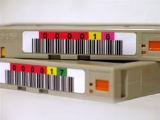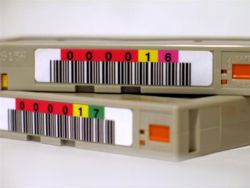
Advanced Intelligent Tape
Encyclopedia
Advanced Intelligent Tape (AIT) is a discontinued high-speed, high-capacity magnetic tape data storage
format developed and controlled by Sony
. It competed mainly against the DLT
, LTO
, DAT/DDS
, and VXA
formats. AIT uses a cassette similar to Video8. Super AIT (SAIT) is a higher capacity variant using wider tape in a larger, single-spool cartridge. Both AIT and SAIT use the helical scan
method of reading and writing the tape.

In March 2010, Sony announced the discontinuation of the AIT product line, and renewed collaboration with Hewlett-Packard
on further development of the DDS tape format
,
The AIT format was developed and is controlled by Sony. AIT backup tapes have backward and forward compatibility.
Memory chip in the cartridge that keeps relevant information about the tape.
Magnetic tape data storage
Magnetic tape data storage uses digital recording on to magnetic tape to store digital information. Modern magnetic tape is most commonly packaged in cartridges and cassettes. The device that performs actual writing or reading of data is a tape drive...
format developed and controlled by Sony
Sony
, commonly referred to as Sony, is a Japanese multinational conglomerate corporation headquartered in Minato, Tokyo, Japan and the world's fifth largest media conglomerate measured by revenues....
. It competed mainly against the DLT
Digital Linear Tape
Digital Linear Tape is a magnetic tape data storage technology developed by Digital Equipment Corporation from 1984 onwards. In 1994 the technology was purchased by Quantum Corporation, who currently manufactures drives and licenses the technology and trademark. A variant with higher capacity...
, LTO
Linear Tape-Open
Linear Tape-Open is a magnetic tape data storage technology originally developed in the late 1990s as an open standards alternative to the proprietary magnetic tape formats that were available at the time. Hewlett-Packard, IBM and Seagate initiated the LTO Consortium, which directs development...
, DAT/DDS
Digital Data Storage
Digital Data Storage is a format for storing computer data on a Digital Audio Tape .DDS uses tape with a width of 3.8mm, with the exception of the latest formats, DAT 160 and DAT 320, which are 8mm wide...
, and VXA
VXA
VXA is a tape backup format originally created by Ecrix and now owned by Tandberg Data. After the merger between Ecrix and Exabyte, VXA was produced by Exabyte Corporation...
formats. AIT uses a cassette similar to Video8. Super AIT (SAIT) is a higher capacity variant using wider tape in a larger, single-spool cartridge. Both AIT and SAIT use the helical scan
Helical scan
Helical scan is a method of recording high bandwidth signals onto magnetic tape. It is used in reel-to-reel video tape recorders, video cassette recorders, digital audio tape recorders, and some computer tape drives....
method of reading and writing the tape.

Form factors
AIT technology was available in two form factors.- AIT – 8 mm, dual reel cartridge, similar to Sony's 8 mm videotape products and Exabyte's 8 mm data tape products.
- SAIT – 1/2", single reel cartridge, similar to DLTDigital Linear TapeDigital Linear Tape is a magnetic tape data storage technology developed by Digital Equipment Corporation from 1984 onwards. In 1994 the technology was purchased by Quantum Corporation, who currently manufactures drives and licenses the technology and trademark. A variant with higher capacity...
and LTOLinear Tape-OpenLinear Tape-Open is a magnetic tape data storage technology originally developed in the late 1990s as an open standards alternative to the proprietary magnetic tape formats that were available at the time. Hewlett-Packard, IBM and Seagate initiated the LTO Consortium, which directs development...
.
In March 2010, Sony announced the discontinuation of the AIT product line, and renewed collaboration with Hewlett-Packard
Hewlett-Packard
Hewlett-Packard Company or HP is an American multinational information technology corporation headquartered in Palo Alto, California, USA that provides products, technologies, softwares, solutions and services to consumers, small- and medium-sized businesses and large enterprises, including...
on further development of the DDS tape format
Digital Data Storage
Digital Data Storage is a format for storing computer data on a Digital Audio Tape .DDS uses tape with a width of 3.8mm, with the exception of the latest formats, DAT 160 and DAT 320, which are 8mm wide...
,
Compatibility
One of the most compelling features of the AIT format is that many generations are both backwards and forwards compatible. This allows multiple generations of tape drives to both read and write to multiple generations of tape media.AIT generations
| Generation | AIT-E Turbo | AIT-1 | AIT-1 Turbo | AIT-2 | AIT-2 Turbo |
|---|---|---|---|---|---|
| Release Date | 2004 | 1996 | 2004 | 1999 | |
| Native Capacity (GB) | 20 | 25, 35 | 40 | 36, 50 | 80 |
| Max Speed (MB/s) | 6 | 3, 4 | 6 | 6 | 12 |
| Tape Length (m) | 170, 230 | 170, 230 | |||
| Tape Thickness (µm) |
AIT-1
- Original specification's data capacity is 25 GB, with a data transfer speed of 3 MB/s.
- Extended length tape, introduced in 1999 gave additional capacity, 35 GB.
- Speed increased to 4 MB/s in 2001.
- Turbo variant, introduced in 2004, is 50% faster (6 MB/s) and holds 40 GB.
- A budget version, AIT-E Turbo, was also introduced in 2004 to compete with DDSDigital Data StorageDigital Data Storage is a format for storing computer data on a Digital Audio Tape .DDS uses tape with a width of 3.8mm, with the exception of the latest formats, DAT 160 and DAT 320, which are 8mm wide...
. - SATA version of AIT-1 Turbo available in 2006.
AIT-2
- Doubled capacity and transfer speed
- WORMWrite Once Read ManyA Write Once Read Many or WORM drive is a data storage device where information, once written, cannot be modified. On ordinary data storage devices, the number of times data can be modified is not limited, except by the rated lifespan of the device, as modification involves physical changes that...
technology introduced - Turbo variant is 50% higher capacity, 100% faster (same speed as AIT-3)
- Turbo variant introduced R-MIC technology
- SATA version of AIT-2 Turbo available in 2006
- Higher capacity TAIT2-80N (Turbo) 80Gb native.
| Generation | AIT-3 | AIT-3Ex | AIT-4 | AIT-5 | AIT-6 |
|---|---|---|---|---|---|
| Release Date | 2001 | 2006 | 2005 | 2006 | cancelled |
| Native Capacity (GB) | 100 | 150 | 200 | 400 | 800 |
| Max Speed (MB/s) | 12 | 18 | 24 | 24 | |
| Tape Length (m) | 230 | 246 | 246 | ||
| Tape Thickness (µm) | |||||
| WORM Capable | YES | YES | YES | YES |
AIT-4
- Doubled capacity and transfer speed
- New tape formulation, AME-2
- Not compatible with previous generations
AIT-5
- Available September 27, 2006
- Announced July 2006, hardware and media expected "in the fall."
- Doubled capacity, maintained transfer speed.
- Backwards compatible with AIT-3, AIT-3Ex, AIT-4
- New tape formulation, AME-3
AIT discontinued
- With the announcement of Sony joining HP to develop DAT/DDS technology, AIT and its road map have been removed and the format is considered End-Of-Life.
SAIT generations
| Generation | SAIT-1 | SAIT-2 | SAIT-3 | SAIT-4 |
|---|---|---|---|---|
| Release Date | 2003 | 2006 | cancelled | cancelled |
| Native Capacity (GB) | 500 | 800 | 2000 | 4000 |
| Max Speed (MB/s) | 30 | 45 | 120 | 240 |
| Tape Length (m) | 600 | 640 | ||
| Tape Thickness (µm) | 8.6 |
SAIT-1
- Highest capacity tape cartridge from 2003 to 2006. Displaced by DLT-S4 (800 GB).
The AIT format was developed and is controlled by Sony. AIT backup tapes have backward and forward compatibility.
SAIT-2
Released in 2006 by Sony, available only in libraries, 800 GB native and 45 MB/s sustained transfer rate.AIT discontinued
- With the announcement of Sony joining HP< to develop DAT/DDS technology, AIT (including SAIT) and its road map have been removed and the format is considered End-Of-Life.
MIC
Memory in CassetteMemory chip in the cartridge that keeps relevant information about the tape.
External links
- SAIT-1 comparison
- ECMA 246 Specification of AIT-1. http://www.ecma-international.org/publications/files/ecma-st/ECMA-246.pdf
- ECMA 291 Specification of AIT-1 w/ MIC. http://www.ecma-international.org/publications/files/ecma-st/ECMA-291.pdf
- ECMA 292 Specification of AIT-2 w/ MIC. http://www.ecma-international.org/publications/files/ecma-st/ECMA-292.pdf
- ECMA 329 Specification of AIT-3. http://www.ecma-international.org/publications/files/ecma-st/ECMA-329.pdf

